
- Magazine First Edition
- Binding
- 3 / 4 Leather (2)
- Brochure / Pamphlet (4)
- Cloth (26)
- Disbound (3)
- Fine Binding (28)
- Half Leather (5)
- Hardback (119)
- Hardcover (171)
- Hardcover W / Jacket (6)
- Leather (45)
- Magazine (57)
- Paperback (8)
- Soft Cover, Stapled (2)
- Softcover (7)
- Softcover / Wraps (4)
- Softcover, Wraps (176)
- Stapled (2)
- Other (3257)
- Features
- 1st Edition (951)
- 1st Edition, Graded (4)
- 1st Edition, Tmnt (4)
- Auto Racing (8)
- Cards (3)
- Collector's Edition (31)
- Complete Edition (3)
- Dust Jacket (4)
- First Edition (15)
- First Printing (6)
- Illustrated (37)
- Limited Edition (10)
- Lot (9)
- Nude (3)
- Original (4)
- Original Edition (4)
- Promo (2)
- Special Edition (8)
- Vintage (65)
- Vintage, 1st Edition (3)
- Other (2748)
- Language
- Publisher
- American Media Inc (40)
- Antiquity (27)
- Condé Nast (72)
- George Newnes (65)
- George Newnes, Ltd (9)
- George R. Graham (6)
- Gerorge Newness (6)
- Harper & Brothers (12)
- Hmh (10)
- Hmh Publishing (17)
- Marvel Comics (8)
- Nintendo (32)
- Nintendo Of America (19)
- Nintendo Power (12)
- Playboy (36)
- Refill Magazine (7)
- Shueisha (15)
- Time (17)
- Time Inc. (6)
- Time, Inc. (8)
- Other (3498)
- Subject
- Americana (43)
- Art & Photography (115)
- Automobile (14)
- Fashion (93)
- Gay & Lesbian (16)
- History (69)
- Illustrated (29)
- Literature & Fiction (82)
- Men's (18)
- Men's Interest (92)
- Music (41)
- Politics (15)
- Pulps (23)
- Science Fiction (24)
- Sherlock Holmes (14)
- Skateboarding (12)
- Sports & Outdoors (9)
- Video Game (50)
- Video Games (10)
- Women's (26)
- Other (3127)
- Year Printed
Scarce 1806 Curtis Botanical Colored Folio Engraving No. 936 LILIUM SUPERBIUM
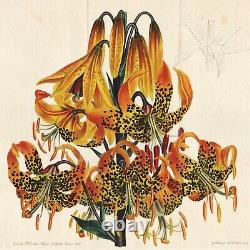
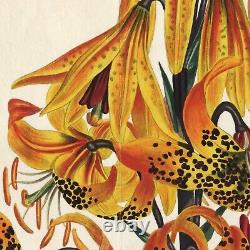
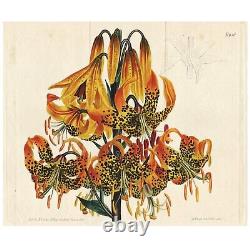
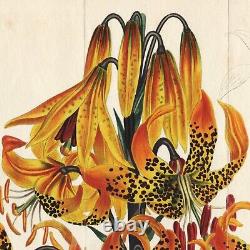
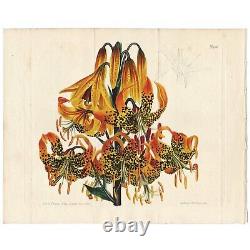
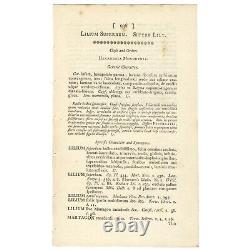



Rare 1809 Hand-Colored Copperplate Engraving from. The Botanical Magazine or Flower-Garden Displayed'. From early volumes of "The Botanical Magazine; or Flower-Garden Displayed" comes this original, Double, fold-out folio copperplate engraving, a rare & sought-after large-format plate from the scarce early volumes. This listing is for the one print from the above work titled thus: No. This one is a stunner.
I'm listing a superb collection of these very scarce folio, fold-out, largest hand-colored engravings from this most important publication documenting the discovery of these flowers. The Double-sized fold-out plates were reserved for the showiest, most dramatic, largest flowers. They were very rare in the series, & yet much more rare in the market, as they can often make the most impressive framed wall-art in terms of scale & image & are sought-after if & when one can be found. This plate is one of the classics of the Curtis volumes.This one is likely a First Edition print, which are generally very rare. Appears to be on the original wove paper, which came to be used in the early years of the 1800's.
After the death of William Curtis, the magazine was published by his brother, Thomas Curtis. Later, Samuel Curtis (a son-in-law of William Curtis) became proprietor from 1801 to 1845.
The prints in the first volumes were copper plates colored by hand. Some of the later prints were lithographs. Some of the distinguished artists were Sydenham Edwards, John Curtis, William Jackson Hooker, W. Fitch, William Graves and Matilda Smith. These prints have a universal beauty and are a lasting documentary contribution to botanical studies.
The Artists: This plate was engraved & hand-colored after a painting by Sydenham Edwards & is signed by'Syd. (Sydenham Teak Edwards, 1768 - 1819) as well as the engraver,'F. The drawing & composition are fluid, bold, lyrical, the coloring is stunning, brilliant, bright, bold. It's one of the boldest of the Sydenham Edwards double plates. These gorgeously drawn, engraved & water-colored original prints were presented on their page with consistently balanced, beautiful compositions. They are full of the passion that the early flower painters, botanists & gardeners had for these amazing flowers, many of which were discovered in the pristine reaches of the ever-expanding British Empire & by intrepid explorers of the time. Every part of these prints was made by hand: Hand drawn & engraved on Copper which was hand-mined, smelted & rolled, printed onto handmade cotton rag paper, inked & colored with hand-ground pigments individually by hand, & they were usually hand sewn into handmade leather-bound books.Condition: Appears to be in excellent condition. The hand-coloring remains sharp & brilliant. The folds in this one are as-issued & appear in all copies I've seen of this plate, as it's a'fold-out' & much larger than the rest which were octavo-sized bookplates.
These prints are very old & may have minor imperfections expected with age, such as some typical age-toning of the paper, oxidation of the old original watercolors, spots, text-offsetting, artifacts from having been bound into a book, etc. Please examine the photos & details carefully. Text Page(s): This one comes without its original text pages.Lilium superbum is a species of true lily native to the eastern and central regions of North America. Common names include Turk's cap lily, turban lily, swamp lily, lily royal, or American tiger lily.
The native range of the species extends from southern New Hampshire, Massachusetts, and New York, west to Illinois, Missouri, and Arkansas, and south to Georgia, Alabama, Mississippi, and Florida. Lilium superbum grows from 3-7 feet (0.91-2.13 m) high with typically three to seven blooms, but exceptional specimens have been observed with up to 40 flowers on each stem. It is listed as endangered in Florida, New Hampshire, Alberta and Saskatchewan and threatened in Kentucky, and exploitably vulnerable in New York. It's been famously painted & engraved by other masters of this art, including Dr.Robert John Thornton for "The Temple of Flora", Pierre-Joseph Redouté & Georg Dionysus Ehret. Size: 9 x 12 inches approximately. If you'd like to combine & need more time to choose, please send a message & we'll do our best to oblige.

